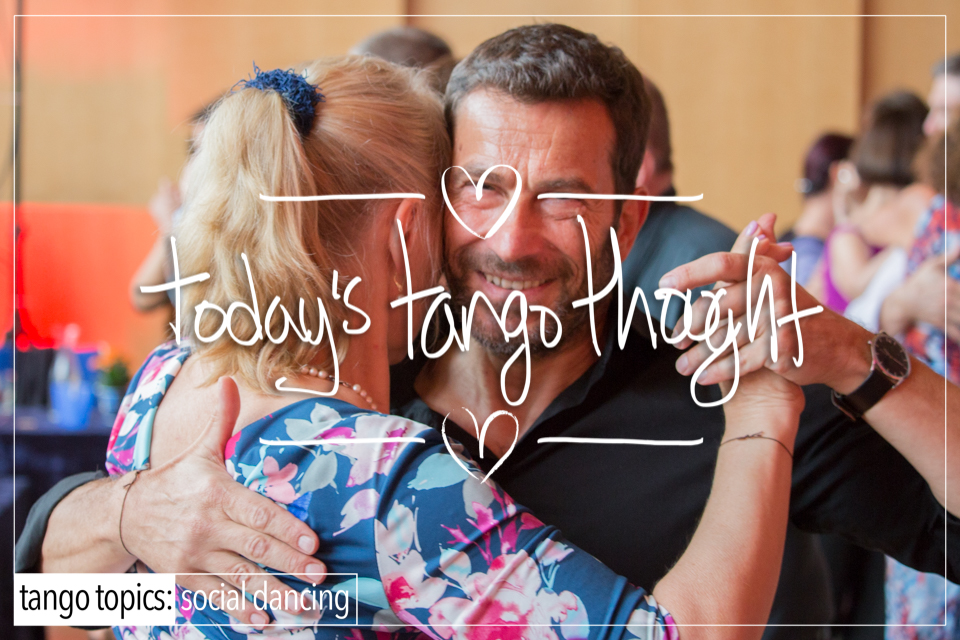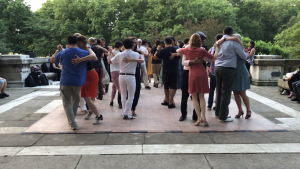Today’s Thought is a very old debate in the Tango world. The Debate ? To step forward as a Lead with a Heel strike first OR a Toe point first.
The Heel Strike Side: This side of the debate says that you can and should, when stepping forward, step forward as if you were walking on the street, normally. You would use the heel in a natural way, allowing it to strike the pavement or the floor (in the case of dancing) as you would normally. There’s nothing about this idea that is new. This is something that you don’t necessarily need to learn a whole lot about, as it just ‘happens’. There’s not a lot to it really.
The Toe Point Side: This side of the debate says is all about the visual and not necessarily the functional. Unlike the Follower, who are in an elevated position and they must accommodate the heel by turning their foot to the 5th metatarsal, the Lead in this case, is all about creating a visual line, and that visual line starts with pointing one’s toe! Everywhere! Put simply, the Lead is the visual representation of what the Follower will ultimately express, so the thinking goes, and that starts with creating nice sharp lines, and detailed junctures or in this case, points! Every time that a Lead steps forward or side, they want to point their toe, defining what the Follower will ultimately fill in. They’re creating a shape, and the Follower fills that shape
Which is better ? Quite honestly neither is ‘better’. It’s what happens. This debate has raged for years, and you’re going to hear a lot of language about how X points his toe and here’s the video proof, or that Y uses a Heel strike and there’s the video on youtube. Yup. Both of those things happen. However the reality is this, that both have their place. It’s not one over the other, but rather a range of ideas that sometimes require you to do one over the other. Put another way this is about vocabulary and musical choices. One idea works better than another under certain conditions that allow for the expression of a particular piece of vocabulary under the condition of a particular musical phrase. So in other words, it is, as in the case of the same plight for the Follower, entirely situational! Leaning both would seem to be the better option. And yet, that’s not what’s advocated sadly.
The Rodriguez ‘Pop’: This particular thought would be remiss if one particular dancer, was not mentioned. One who really set a trend for many younger dancers to follow was/is Javier Rodriguez. He accentuated an ideal of a Lead walk that many, many dancers emulated and put into their dance. One reason for the emulation was that it was striking, visually appealing, and singularly unique. For most people it seemingly settled the debate entirely of which is better because he accentuated BOTH ideas in one. You could easily argue (and many have) that he’s pointing his toe as he extends, and at the end of the point, he’s landing with heel strike (which incidentally results in the aforementioned). When in fact, what Javier was doing was a perfectly natural ‘pop’ off the floor as a result of his heel strike! However that didn’t stop a fair number of people attempting to emulate what Javier was doing.https://www.youtube.com/embed/Gl32aaB136g
Tango Topics Opinion. The Lead steps forward, depending on the context of the floor, about 40 to 60% of the time. They spend most of their time, in modern tango, turning or invoking one of 8 types of Turns. And if we’re being honest, really honest, a good portion of them spend most of their time stuck in a Parallel Walking Argentine Rock Step, or Argentine Parada Loop!
Two Sides of the same Coin ? The line of reasoning is that if you’re going to spend that much time doing something, you should probably learn to do it well. Unfortunately, that’s not what happens. What ends up happening is that a good portion of Leads learn just enough to get around the floor and not go any further than that. Why bother ? Right ? No one is complaining, or the feedback has stopped (mostly because they stopped asking for it), so why bother going any deeper ? The fact is that you absolutely must go deeper, you must go beyond your original programming and honestly find out why this stuff works as indicated and not just accept that X is true. It’s not. Not until you figure it out for yourself. The reason ? Is because more than likely you will actually start to discover that what you’ve been doing all along may not be in your best interest and that with a little judicious behavior and forethought that you can improve the quality of your dance, which thereby improves the experience of the Follower!
The 1 Thing Not Mentioned: The Knee! In the case of the Toe Side of the Argument, the Knee does NOT want to bend a lot or the flex of the knee is very, very, very slight as we want to create long, clean, straight lines with this methodology, and therefore bending or flexing the knee breaks that convention. In the case of the Heel Side of the Argument, the knee can and does want to flex! Just so you’re aware of this stuff, Tango Topics does have an extensive video on both of these ideas that is available to subscribers.











